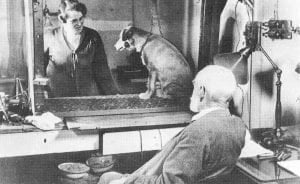What is Applied Behavior Analysis?
A scientific approach to developing procedures that will produce observable changes in bahavior. It follows various guidelines and principles that involve observing, recording, and accountability.
- Applied - Changing behaviors that will be significant. You are APPLYING techniques to change behavior for the betterment of both the animal and owner.
- Behavior - Anything that an animal/person does that can be observed.
- Analysis - The ability to interpret the results of the plan and modify as necessary to achieve goals.
The History of Applied Behavior Analysis
Ivan Pavlov
- Classical Conditioning
- Conditioning of reflexes
- Dogs were used to pioneer the science
John B. Watson
- Established and defined behaviorism in the USA (influenced by Pavlov)
- Argued psychology must focus on observable behavior that can be measured vs unmeasurable internal processes (Sigmond Freud)
- More objective in methods and terminology
- Conditioning of emotions (little Albert experiments)
B.F. Skinner
- Most of his original studies were done with animals
- Operant Conditioning (learning through consequences)
- Early pioneer to ABA
- applications to education/children
- animal training for government duties
Applied Animal Behavior / Animal Behavior Analysis / Applied Animal Psychology
- Keller and Marian Breland
- Graduate students of Skinner
- Animal Behavior Enterprises (ABE)
- I.Q. Zoo
- Evolutionary contingencies and Instinctual drift
- Bob Bailey
- Navy's dolphin program
- Many projects for commercial and military
The original referenced video in the lecture was taken down by the uploader, but this is an OK replacement to learn about the heart of Bob Bailey's philosophies: https://www.artandscienceofanimaltraining.org/videos/2016-video-bob-bailey/
Components of Applied Behavior Analysis
-
Applied: Training focuses on the social significance, in the real world, of the behavior being modified or created.
-
Behavioral: Training is practical; it asks how it is possible to get a dog to do something effectively? To answer this question, the behavior itself must be objectively measured.
-
Analytic: Training is successful when the trainer understands and can manipulate the events that control a target behavior. This may be relatively easy to do in theory or in an empty training room, where a trainer can arrange the relevant events, but it is not always easy, or ethical, in an applied situation. The effectiveness of the intervention is revealed by changes in just the behavior to which the intervention is being applied.
-
Technological: The description of a training plan must be clear and detailed so that any competent trainer can repeat it accurately. This is the standard way to check this: Have a trainer read the description and then act out the procedure in detail. If the trainer makes any mistakes or has to ask any questions, then the description needs improvement.
-
Conceptually Systematic: Dog training should not simply produce a list of effective interventions. Rather, to the extent possible, these methods should be grounded in behavioral principles. This is aided by the use of theoretically meaningful terms, such as “conditioned reinforcement” or “generalization” where appropriate.
-
Effective: Though training methods should be theoretically grounded, they must be effective. If an intervention does not produce a large enough effect for practical use, then the training has failed.
-
General: Training should aim for interventions that are generalizable; the methods should work in different environments, apply to more than one specific behavior, and have long-lasting effects.
-
Accountable: To be accountable means that a training outline must be able to demonstrate that it is effective. This requires repeatedly measuring the success of plans, and, if necessary, making changes that improve their effectiveness.
-
Published: The methods, results, and theoretical analyses of training plans must be published and open to scrutiny. There are no hidden treatments or mystical, metaphysical explanations. References and statistics should be used whenever possible.
-
Doable: To be generally useful, training plans should be available to a variety of individuals, who might be pet owners, working dog handlers, or animal shelter workers. With proper planning and training, many plans can be applied by almost anyone willing to invest the effort.
-
Empowering: Training plans should provide tools that give the trainer feedback on the results of interventions. These allow trainers to assess their skill level and build confidence in their effectiveness.




I split up watching the Bob Bailey video (2020 Winter Summit) over several days because of the length of the video; but what an amazing watch. Some of the things he’s done are mind-blowing. Bob Bailey – with as much as he did with/for animals, never owned his own dog/animal, and isn’t actually an animal lover (that was a tremendous surprise!). There are so many things to glean from his experiences, but a couple of things he said will always stick with me: “animal training is simple, but it isn’t easy,” and “don’t forget the mechanical skills.” 🙂
You need to login in order to like this post: click here
I don’t think that 3 hours long video is available any more. I remember that girls which organised that summit decided to move on and not continue with summits project. Pity I couldn’t see it at that time and now is gone.
You need to login in order to like this post: click here
Video gone since 25 Jan 2021
You need to login in order to like this post: click here
I was very upset to see the video removed. It was the most generous interview I ever saw from Bob Bailey and I know it is his desire to “data drop” his knowledge for the next generation.
For now, I put this link to replace the interview which I still think is good and does demonstrate the heart of Bob Bailey’s philosophy: https://www.artandscienceofanimaltraining.org/videos/2016-video-bob-bailey/
You need to login in order to like this post: click here